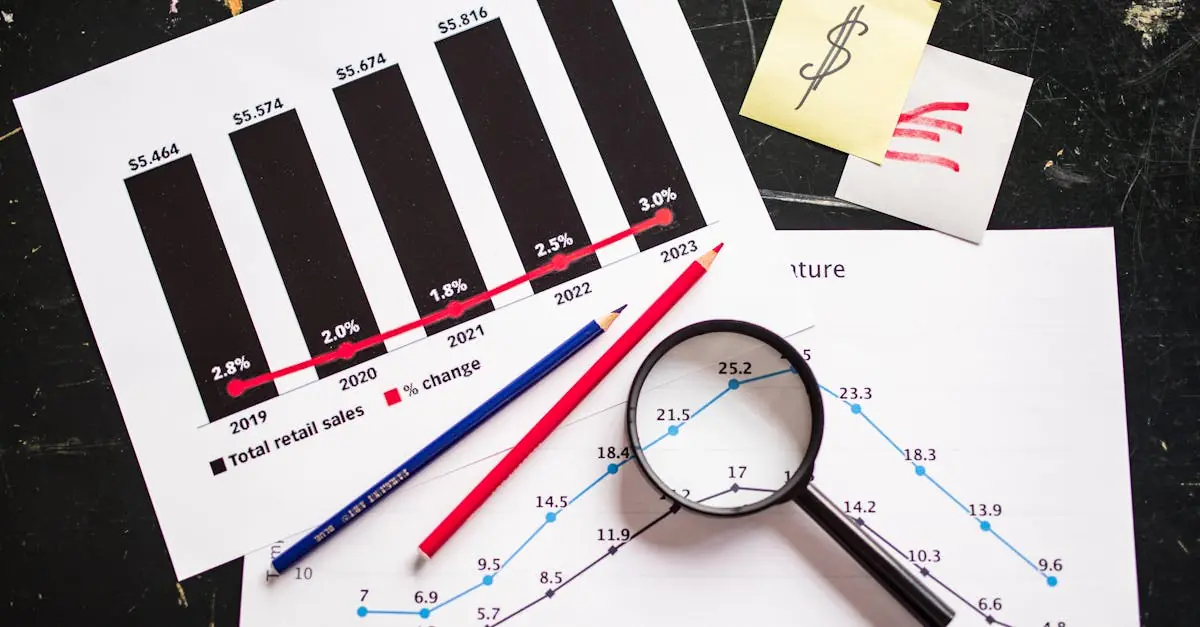Table of Contents
ToggleElection years are like a rollercoaster for the stock market—filled with twists, turns, and the occasional stomach drop. Investors often find themselves glued to their screens, trying to predict whether a candidate’s policies will send stocks soaring or crashing down. It’s a wild ride, but one that can lead to some serious profits for those who know how to navigate the chaos.
As the political landscape shifts, market performance tends to follow suit, creating a unique relationship between the two. Understanding how elections impact stock prices can turn a novice investor into a savvy market player. So, buckle up and get ready to explore the fascinating world of stock market performance during election years—where every vote counts and every stock tick may just be a reflection of the nation’s mood.
Overview of Stock Market Performance
Stock market performance often varies during election years due to political uncertainty. Research shows that the average return for the S&P 500 in election years is around 7.3%, compared to 2.7% during non-election years. Historical trends indicate that markets tend to rise before elections, with a notable increase during the last quarter of the election cycle.
Political parties influence market behavior significantly. Typically, markets react positively to perceived stable governance, while uncertainty surrounding elections can lead to volatility. Candidates’ policies, especially regarding taxes and regulations, play a crucial role in market performance. Changes in government can prompt shifts in investor sentiment, impacting investment strategies.
Investors often closely follow pre-election polls and debates. Monitoring these events provides insights into potential market movements. As candidates present their platforms, sectors may show varying reactions based on expected benefits or drawbacks. Technology and healthcare stocks frequently experience fluctuations linked to candidate proposals.
Additionally, post-election outcomes influence long-term market performance. Historically, the first year of a new presidency tends to align with market gains. Data shows that markets particularly thrive during Democratic administrations, with average annual returns around 10.6%. Conversely, Republican administrations yield average returns closer to 6.7%.
Understanding the nuances of stock market performance during election years empowers investors. Analysis of trends and historical data equips them to navigate the complexities of political influence on the market effectively.
Historical Trends
Stock market performance shows notable patterns during election years. These trends provide insights for investors aiming to navigate political patterns effectively.
Election Year Cycle
Election cycles often feature heightened market activity. Historical data reveals that the S&P 500 averages a return of 7.3% during election years, notably higher than the 2.7% seen in non-election years. Markets generally rise in the months leading up to elections, particularly in the last quarter. Political parties influence these cycles, as consistent governance tends to reassure investors. Uncertainty surrounding election outcomes can trigger volatility, making it essential for investors to stay informed.
Market Reactions
Market reactions to elections hinge on various factors. Candidates’ policies can sway investor confidence and sector performance. Technology and healthcare sectors frequently experience significant fluctuations based on proposals made during campaigns. Additionally, markets often react positively to the outcomes of elections. Historical trends show that the first year of a new presidency typically aligns with market gains. Statistical analysis indicates that Democratic administrations yield average annual returns of 10.6%, compared to 6.7% under Republican leadership.
Factors Influencing Stock Market Performance
Election years create a complex environment for stock market performance. Various influences, especially political and economic factors, shape investor behavior and market results.
Political Climate
Political events significantly sway stock market trends. Uncertainties surrounding candidates and their platforms can lead to heightened volatility. Important policy proposals create expectations, impacting sectors unevenly. For example, proposals in technology or healthcare can ignite investor interest, driving up stock prices. Conversely, surprising developments or controversial debates can trigger sharp declines. Investors closely track polling data and election forecasts to gauge potential market reactions. Stable leadership typically fosters investor confidence, while contested elections often induce market caution.
Economic Indicators
Economic indicators provide critical insights into stock market performance during election years. Data such as GDP growth, unemployment rates, and inflation trends offer a financial backdrop for market trends. Strong economic signals tend to uplift market sentiments, boosting stock prices. In contrast, weak indicators can breed uncertainty, causing declines. Historical performance shows that an economy in a preferred position often leads to favorable stock outcomes. Market reactions to economic news are amplified during election cycles, as investors anticipate how government policies may shift with changing administrations.
Case Studies
This section examines specific instances of stock market performance during election years, focusing on presidential and midterm elections.
Presidential Elections
Presidential elections significantly influence the stock market. Historically, the S&P 500 averages a return of 7.3% during election years. Markets often see an uptick in the months leading to the election, with positive investor sentiment driven by anticipated policy changes. In particular, the first year of a new presidency frequently correlates with market gains. Democratic administrations have shown an average return of 10.6%, whereas Republican ones average 6.7%. Political certainty plays a crucial role; risks associated with candidates can create volatility, while stable governance tends to inspire investor confidence.
Midterm Elections
Midterm elections also affect stock market trends, albeit differently from presidential elections. The average market return during midterm years rests at around 6%, showing that investor reactions often align with political shifts. Uncertainty resulting from policy proposals can lead to increased market volatility. A pattern emerges, where the market usually rallies after the midterms, driven by reduced uncertainty regarding legislative agendas. Historically, the stock market has tended to perform better post-election, especially when one party maintains control of Congress, creating a favorable environment for business.
Investor Strategies
Investors must adapt their strategies during election years. Understanding market timing can significantly enhance portfolio performance.
Market Timing
Investors often see market movements linked to political events. Anticipating trends before elections leads to informed decisions. The S&P 500 averages a return of 7.3% during presidential election years, making these moments crucial for entry points. Seasonal patterns reveal that markets typically rally in the months prior to elections. Targeting strong sectors like technology and healthcare right before significant political developments can yield substantial profits. Recognizing these intervals allows investors to capitalize on potential gains.
Risk Management
Risk management remains a priority during volatile election cycles. Investors should develop a diversified portfolio focused on sectors that are less sensitive to political changes. Monitoring economic indicators, including GDP growth and unemployment rates, provides context for necessary adjustments. Limiting exposure to high-risk stocks during uncertain periods helps protect investments. Implementing stop-loss orders can safeguard against sudden market downturns after elections. Adopting these strategies equips investors to navigate fluctuations while preserving capital.
Navigating the stock market during election years requires a keen understanding of the interplay between politics and market dynamics. Investors who grasp these relationships can position themselves to capitalize on potential opportunities while mitigating risks.
Staying informed about political developments and sector-specific impacts can enhance decision-making. With historical trends indicating that election years often yield higher returns, particularly in the months leading up to elections, investors can adopt strategies that align with these patterns.
Ultimately, awareness and adaptability are key. By monitoring economic indicators and political shifts, investors can better navigate the uncertainties of election cycles, ensuring their portfolios remain resilient amidst the fluctuations.




